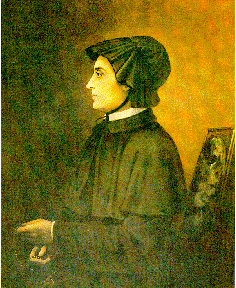St. Elizabeth Ann Seton was born Elizabeth Bayley in New York in 1774, the daughter of Dr. Richard Bayley — the first professor of anatomy at Columbia College — and Catherine Charlton, daughter of an Anglican minister. Elizabeth’s mother died when Elizabeth was only three years old. Her father remarried and Elizabeth got along very well with her stepmother and stepbrothers and sisters. The family was all of the Anglican faith and Elizabeth was very religious. She always wore a crucifix around her neck and loved to read the Scriptures.
Elizabeth married William Seton in 1794 and struck up a wonderful friendship with her sister-in-law, Rebecca Seton. Together, they went about on missions of mercy and became known as the “Protestant Sisters of Charity.” Elizabeth was very happy, her family was prominent and wealthy and she was doing the Lord’s work. Things couldn’t have been better. Then, in 1798, her father-in-law died and Elizabeth and her husband found themselves the caretakers of the large orphaned family. Soon after, her husband’s health also started to fail and they went to Pisa, Italy, in hopes of finding medical help for him. But he died there, and Elizabeth was widowed with five children.
She remained in Pisa for a while after his death, living with a Catholic family. While residing and attending Mass with them, she soon fell in love with the Catholic faith and came to realize that was where she belonged. She returned to the United States in 1805 and was received into the Church by Fr. Matthew O’Brien at St. Peter’s Church in New York. This event led to her ostracization by her Protestant family and friends. When she and a Catholic couple tried to open a school for boys in the suburbs of New York, some started the rumor that they were trying to convert the boys to Catholicism and the school was forced to close.
In 1806, Elizabeth’s youngest sister-in-law Cecilia Seton became very ill and insisted on seeing her ostracized family member. Elizabeth was summoned and became a constant visitor. Cecilia told her that she, too, desired to become a Catholic. When Cecilia’s decision was made known, threats were made to have Elizabeth expelled from the state by the legislature. When Cecilia recovered from her illness she fled to Elizabeth for refuge and was received into the Church.
Three years later, Elizabeth was asked to open a school in Baltimore by Fr. Dubois, rector of St. Mary’s Seminary there. Along with four others, Elizabeth founded a religious community called the Sisters of Saint Joseph and a school for poor children. The new community was approved by Archbishop Carroll of Baltimore, and in 1812, Elizabeth was elected superior. With 18 other women, she took her vows in 1813, founding the Sisters of Charity, the first American religious society. By the time of Elizabeth’s death in 1821, there were some 20 communities.
She was canonized by Pope Paul VI in 1975, the first American-born saint.
Lessons
Elizabeth endured great persecution when she converted to the Catholic Church, including loss of communication with family members and friends. Even during her time as Mother Superior of the Sisters of Charity, her suffering continued. There were great trials including the loss of her own children. Her daughter Anna died during her novitiate, but was allowed to pronounce her vows on her deathbed. Another daughter, Rebecca, also died after suffering through a long illness. Elizabeth never swayed in her faith and her zeal to help others, and because of her hard work and perseverance, many people were helped and many souls brought to the Lord.
From Johnnette Benkovic’s Graceful Living: Meditations to Help You Grow Closer to God Day by Day
Live simply, so that all may simply live.
— Traditionally attributed to St. Elizabeth Ann Seton
Today, I will do an examination of conscience according to this teaching and ask myself these questions: What two virtues are implicit in this quotation? To what extent has a consumerist mentality prevented me from living these virtues? What positive steps can I take, beginning today, to remedy this situation?
Prayer
Father, we are so glad that you called Elizabeth to the Catholic faith and for all she accomplished for others in her lifetime. We thank you for her great spirit and example and pray that you will raise up many others like Elizabeth in our country to be great saints that we may emulate. Amen.













